Abstract
This paper investigates the extent of gross premium distributions inequality for life and non-life insurance in Croatia in the period 2000–2012. The number of companies for life insurance was the same in 2000 and 2012, at 17. The number of non-life insurance companies varied between 16 and 24, and was 20 at the end of 2012. The Lorenz curve and nine numerical concentration measures applied mostly show a slight decrease of a moderate concentration for both types of insurance over time, with only the Rosenbluth index being an exception, showing a mild increase of concentration. The concentration of gross premium is slightly stronger for non-life then for life insurance.
The standard errors of the trend models for the entropy indexes are smaller, and coefficients of determination are higher for the quadratic compared to the linear trend models for both types of insurances, life and non-life. Since the forecasts’ quality measures for both types of insurance show that the quadratic trend is superior compared to the simple linear trend model, it was used for short-term forecasting of the entropy indexes. The quadratic trend model gave forecasts showing digressive-progressive dynamics for non-life, and progressive-digressive for life insurance entropy indexes.
1. Introduction
The insurance market in Croatia began to develop in 1990s. Until then, the insurance company Croatia Ltd., as the state insurance institute that used to cover more than 80% of risks, had held an explicit monopolistic position in the insurance market. The concentration level is the common measure of market power in the industry. The market power defines the level of control that only one company or a small number of companies have over key decisions in a particular industry.
The goal of the paper is to study inequality of gross written premium distributions for insurance companies in Croatia in the period 2000–2012 for life and non-life insurance. The aim is to recognise the number of most significant participants in the insurance industry in Croatia as well as the dynamics in the observed period using ten inequality measures for measuring gross written premiums of life and non-life insurance concentration.
The following hypotheses can be defined:
Hypothesis 1: Inequality of distribution of gross written insurance premiums in Croatia exists.
Hypothesis 2: The concentration of gross written insurance premiums in Croatia is different for life and non-life insurance.
There are several papers presenting studies elaborating the concentration or inequality of assets and some other financial variables’ distributions over the total number of financial institutions as market subjects in Croatia, such as banks (Dumičić, Čeh Časni, & Čibarić, Citation2008; Dumičić, Pavković, & Akalović Antić, Citation2012; Ljubaj, Citation2005; Tipurić, Kolaković, & Dumičić, Citation2003); investment funds (Morić Milovanović & Galetić, Citation2005; Valdevit, Čibarić, & Žmuk, Citation2008); pension funds (Bahovec, Dumičić, & Žalac, Citation2011). A study of the insurance markets of the transition countries of Central and Eastern Europe in 1990s is presented by Tipurić, Pejić Bach, and Pavić (Citation2008) and Bauer (Citation2012), showing similar results, but these results are based on using of only several number of concentration measures.
The main contribution of this paper is in applying a larger number of inequality, i.e. concentration measures. Since different features of the applied measures resulted in slightly different conclusions about the direction and the extent of gross written premium concentration for both types of insurance, these results are discussed.
2. Characteristics of the insurance market in Croatia
2.1. Croatian insurance market
The highly developed European insurance market has a large share in the total global insurance premium volume. The gross domestic product in Croatia in 2010 amounted to 45,917 million euros, the total assets of the financial sector amounted to 70,024 million euros, which is 153% of GDP, and insurance and reinsurance assets amounted to 4,136 million euros, 5.91% of total financial sector assets. The share of insurance premiums in Croatian GDP continued the downward trend that had begun in 2007 and was 2.76% in 2010 and 2.68% in 2011. In the life insurance segment, its share is 0.71% while in non-life insurance segment it amounts to 1.97% (Jakovčević & Krišto, Citation2012). In comparison to 2010, the indicators show a decrease of the importance of the insurance premiums in relation to GDP. The above-mentioned shares for Croatia are significantly higher than in Croatia’s eastern neighbouring countries, while in comparison to the developed European Union countries Croatia is significantly falling behind.
Although the Croatian insurance market is developing and changing (Jakovčević, Citation2009), specific characteristics are still predominant on the Croatian financial and insurance market (Jakovčević & Krišto, Citation2012). These features are: the financial market is developing, and the insurance industry stagnates in comparison to other participants in the financial market; the insurance sector is functionally, organisationally and technologically underdeveloped, and in 2011 it accounted for 2.6% of Croatian GDP; the offer is focused on non-life insurance, and the development of the types of insurance encouraging saving is insufficient. Further, there is a significant share of car liability insurance, and a low share of life insurance; there is also a high percentage of investment into deposits, loans and real estate; there is also weak risk management, unfair competition, a low level of transparency; there are instances of bad experiences with claim payouts, and much litigation.
2.2. Overview of insurance companies in Croatia
The number of insurance companies in Croatia changed during the observed period from 2000 to 2012. As shown in Figure , the total number of insurers participating in forming the insurance gross premium in 2000 was 26 and in 2012 it slightly increased to 27. The number of insurance companies that provided life insurance services in the observed period remained the same, i.e. 17 companies at the beginning and at the end of the period, while the number of insurance companies providing non-life insurance services reduced from 24 to 20 in the observed period. It is also noticeable that the number of insurance companies active on the market was lowest in 2006. Although the number of insurance companies on the market changed throughout the years, the changes were not extreme and are therefore insignificant.
Figure 1. The number of insurance companies in Croatia in the period 2000–2012, Source: Economic reports and statistics (Citation2013), Croatian Insurance Bureau, Authors’ calculations.
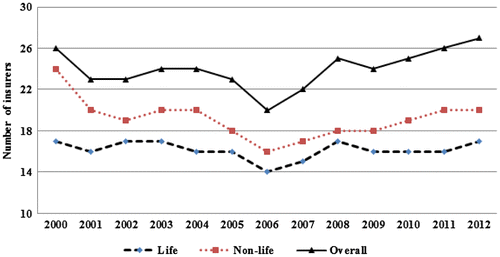
In 2012, based on total gross written premiums, the largest insurance companies in Croatia were: Croatia Osiguranje Ltd. (29.96% of the total insurance market), Allianz Zagreb Ltd. (12.05%), Euroherc Osiguranje Ltd. (10.30%), Jadransko Osiguranje Ltd. (6.94%) and Kvarner Vienna Insurance Group Ltd. (4.56%). Based on the gross written premiums for non-life insurance, the largest shares are held by the following insurers: Croatia Osiguranje Ltd. (35.64%), Euroherc Osiguranje Ltd. (14.85%), Allianz Zagreb Ltd. (10.33%), Jadransko Osiguranje Ltd. (9.53%) and Triglav Osiguranje Ltd. (4.24%). Finally, the leading insurers in the life insurance segment are: Allianz Zagreb Ltd. (16.66%), Croatia Osiguranje Ltd. (14.78%), Merkur Osiguranje Ltd. (10.35%), Grawe Hrvatska Ltd. (10.19%), and Agram Životno Osiguranje Ltd. (8.26%).
2.3. Gross premiums of insurance companies in the period from 2000 to 2012
The total gross written premium of insurance companies in 2000 in Croatia amounted to 4,530,617,000 HRK. Gross premium realised from life insurance amounted to 739,466,000 HRK, and from non-life insurance to 3,771,438,00 HRK. The largest written premium was realised by Croatia Osiguranje Ltd. with 2,337,008,000 HRK, which amounts to 51.58% of the total gross premium. In 2012, the total gross written premium rose to 9,037,642,000 HRK. Out of that 6,576,454,000 HRK came from non-life insurance premiums, and 2,461,188,000 HRK from life insurance premiums. The largest premium of 2,707,693,000 HRK was again realised by Croatia Osiguranje Ltd., which amounts to 29.96% of the total gross premium. If the total insurance premium range per companies is analysed, in 2012 the lowest premium amounted to 1,179,000 HRK and the highest amounted to 2,792,782,000 HRK.
Looking overall insurance industry, as shown in Figure , in the period from 2000 to 2008 the Croatian insurance market experienced a noticeable rise of the gross written premium for insurance of 113.5%. In 2012, there was a fall of 6.6% in total compared to 2009. In total, there was still a significant rise of 99.47% in the gross written premium in 2012 compared to 2000.
Figure 2. Gross written premiums of insurance companies in Croatia in the period 2000–2012, in HRK. Source: Economic reports and statistics (Citation2013), Croatian Insurance Bureau, Authors’ calculations.
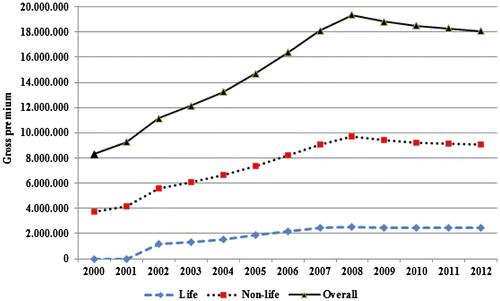
3. Measuring concentration for insurance gross written premiums in Croatia in the period 2000–2012
3.1. Concentration measures features
The concept of concentration is one of the basic elements of the analysis of competitiveness and market structures, i.e. the market power in an individual industry (Bikker, Citation2004). Concentration is used in relation to the control of a certain economic growth or activity. Concentration occurs when a minor segment of the total number of subjects monitoring a resource monitors the major part of the total resource.
In this paper, the authors decided to apply ten different concentration measures, and to study their dynamics over time from 2000 to 2012, in order to recognise whether all of them support the same conclusion for each type of insurance, life and non-life. Table lists the most important characteristics of these measures, defined in e.g. Martić (Citation1986).
Table 1. The review of the concentration measures characteristics.
In this paper, concentration measures will be used for calculating concentration on the insurance market in Croatia in the period 2000–2012. For calculating concentration measures individual data for the gross written premiums per insurance companies in Croatia were used separately for life and non-life insurance. A higher level of concentration implies that a minor number of big companies realise a significant share of the industry’s sales. The opposite also applies; the lower industry concentration indicates the existence of a larger number of relatively small companies. Table provides an overview of used measures and the interpretation of their meanings.
3.2. Calculated concentration measures for life insurance gross premium
The Table presents all calculated measures of the life insurance gross premium concentration in Croatia in the period 2000 to 2012, according to formulas given in Martić (Citation1986).
Table 2. Overview of concentration measures for life insurance gross premiums in Croatia in the period 2000–2012.
Concentration ratios C2 and C5 were calculated for the largest two and the largest five life insurance companies in Croatia. The results show that the concentration ratio C2 for life insurance in 2012 fell (31.4%) in comparison to 2000 when it had its highest value (38.8%), with the same number of active insurance companies in the market. In the same period, the concentration ratio C5 also decreased from 79.73% in 2000 to 60.24% in 2012.
Furthermore, based on the results in Table , it is evident that the Herfindhal-Hirschman index (HHI) value for life insurance in the observed period decreased. It amounted to a relatively high 0.154 in 2000 when it reached its maximum level, leading to the conclusion that the Croatian life insurance market at the time was mildly concentrated, i.e. there was an oligopoly market structure. A value of HHI higher than 0.1 had been present in the life insurance market up to 2008. Since 2009, it decreased below 1 to 0.095, which indicates a decrease in concentration and the life insurance market. Since 2009 life insurance market, fragmentation is enabling the total gross premium for life insurance to be distributed among an increasing number of insurance companies.
The normalised Gini coefficient (G*) decreased in the observed period, but it sank below the borderline of 0.5 only in 2004 and it rose above it again in 2008. Its lowest value of 0.383 was, as well as the Gini coefficient (G), in 2006. Based on a normalised Gini coefficient, one can conclude there was no significant concentration on the life insurance market in the observed period since 2004, except for 2008.
Table shows that the Theil’s entropy (H) and the normalised entropy (H*) value for life insurance gross premium throughout the observed period increased moderately while maximum entropy (Hmax) values were approximately unchanged, with the exception of the year 2006 when the maximum entropy was at its minimum of 2.639. Since the entropy value is negatively correlated with the concentration level in the industry, due to the observed increase of entropy measures it can be concluded that the concentration of gross premium for life insurance in the observed period decreased. The normalised entropy had its maximum value in 2006 and the entropy measure in 2010 indicating the lowest concentration of life insurance gross premiums in those years. On the other hand, the minimum entropy measure values were in 2000 indicating the highest concentration of life insurance gross premiums in that year.
Furthermore, the Hall-Tideman (HTI) concentration index is the highest in 2000 when it amounted to 0.1525 while it was at its lowest in 2011 with the value of 0.1045. In the period from 2000 to 2012, the HTI dropped from 0.1525 to 0.0984, i.e. it went closer to zero, implying that there was a fall in concentration on the life insurance market. Based on an HTI index close to zero, one can conclude that there is no monopoly on life insurance market, and there is a significant number of insurance companies of the same size.
The Rosenbluth index (RI) of gross premiums for life insurance had the lowest value in 2000 and the highest in 2006. For RI there is no regular tendency to increase or decrease within the observed period, but it did change slightly over the years, with the exception of the period from 2006 to 2008 when a significantly pronounced decrease of gross premiums for life insurance was observed.
Generally speaking, it should be said that the HHI, the RI and the entropy H belong to the same group of concentration indices (Jacquemin, Citation1987). All these three indices are used to measure the concentration percentage shares of individual subjects in the insurance market. However, indices differ in terms of highlighting different aspects of the market structure. The HH index gives weight to large insurers, while the entropy index H tends to emphasise small insurers in shaping the overall index. Moreover, the RI includes not only the proportion of the insurers’ market, but also the rank of the insurers as the market subjects. Thus, HH index is relatively insensitive to changes in the proportion of smaller insurers, while the RI reacts strongly, because it gives different importance to small insurers. In this study, only the RI indicates an increase in concentration for both life and non-life insurance gross premiums over the observed period.
3.3. Calculated concentration measures for non-life insurance gross premium
Table presents all calculated measures of the gross premium concentration for non-life insurance in Croatia in the period from 2000 to 2012.
Table 3. Overview of concentration measures for non-life insurance gross premiums in Croatia in the period 2000–2012.
In 2000, when there were 24 insurers providing non-life insurance services in the market, the ratio C2 equals 68.66% while in 2012 its value decreased to a still high 50.49%. The ratio C5 amounted to a high 85.33% in 2001, and fell to 74.59% in 2012. The values of both concentration ratios C2 and C5 show a high concentration on the non-life insurance market in Croatia during the completely observed period.
In addition, on the non-life insurance market, the value of the indicator HHI reached its maximum in 2005 when it amounted to 0.162, which was the closest to the borderline of 0.18 indicating a high concentration on the market. During the observed 12-year period, the HHI values neither fell below 0.114 nor rose above 0.162, i.e. they remained within the limits that define the oligopoly market structure on the non-life insurance market. Finally, based on the HHI values, which were above 0.1 throughout the entire period, one can conclude that the non-life insurance market is moderately concentrated.
The normalised Gini coefficient (G*) for non-life insurance decreased from 0.662 in 2000 to 0.597 in 2012 indicating a decrease of concentration of the gross premium for non-life insurance. However, based on G* it can also be concluded that there is a large concentration of gross premium on the non-life insurance market taking into consideration the calculated values which were above 0.5 throughout the observed period. It had its highest value of 0.684 in 2004, while its lowest value amounted to 0.543 in 2009.
Table shows a fall of the entropy (H) and the maximum entropy (Hmax) value for the non-life insurance gross premium when comparing the beginning and the end of the observed period. The value of normalised entropy (H*) shows a slight increase.
The measure HTI of the non-life insurance gross premium shows a visible fall from its highest value of 0.2217 in 2001 to its lowest value of 0.1318 in 2012, which also testifies to the non-life insurance market fragmentation in the observed period.
For the non-life, insurance gross premium the measure RI also had its lowest value in 2000 amounting to 0.0233, and the highest value in 2006 amounting to 0.0374. From 2009 to the end of the observed period, there was a moderate fall of the measure RI for the non-life insurance gross premium, which is in accordance with the moderate increase of the number of insurers in the period in question.
The comparison of the RI values at the beginning and the end of the observed period testifies on the moderate rise of the index for both types of insurance.
3.4. The Lorenz curve
This section of the paper shows representations of the Lorenz curve for life and non-life insurance in selected years.
Figure , for life insurance gross premium in 2000 and 2012, shows the Lorenz curve approaching the line of perfect equality in 2012 more closely than in 2000. That leads to the conclusion that the concentration of the life insurance gross premium decreased in the observed period.
Figure 3. Lorenz curve for gross premium for life insurance in Croatia 2000 and 2012. Source: Economic reports and statistics (Citation2013), Croatian Insurance Bureau, Authors’ calculations.
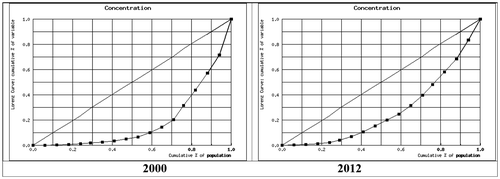
Figure shows that the Lorenz curve for non-life insurance gross premium was more distant from the line of perfect equality in 2000 than in 2012. This indicates that there was a decrease of concentration of the gross premium for non-life insurance in the observed period.
Figure 4. Lorenz curve for gross premium for non-life insurance in Croatia 2000 and 2012. Source: Economic reports and statistics (Citation2013), Croatian Insurance Bureau, Authors’ calculations.
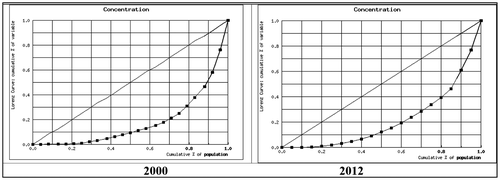
When comparing the Lorenz curves for gross premiums for life and non-life insurance for 2012, based on Figure and Figure , the Lorenz curves show that the concentration of gross premiums for life insurance is lower than for non-life.
4. Trend modelling for the entropy index for gross premiums of life and non-life insurance in Croatia in the period 2000–2012
4.1. Estimated quadratic trend models and forecasts
Theil’s entropy is a measure of the amount of unused energy in a closed thermodynamic system, introduced into the economy by Henry Theil (Cowell, Citation2003), who took the measure of entropy in information theory, using as a measure of diversification, i.e. concentration or inequality.
With the aim of describing the concentration dynamics, two regression-based trend models were applied for estimating and forecasting the dynamics of entropy measures for both life and non-life insurance gross written premiums. For the purpose of choosing a better forecasting model, Table presents a comparison of measures of representativeness of the simple linear and the quadratic trend models applied, both based on ordinary least squares estimators for the regression coefficients. Since all forecasts’ quality measures, such as Mean Absolute Percentage Error (MAPE), Mean Absolute Deviation (MAD) and Mean Squared Deviation (MSD) for both types of insurance are smaller for the quadratic type of trend model, this model is superior in comparison to the simple linear trend model. Therefore, it is used for short-term forecasting.
Table 4. Forecast measures for trend models for the gross premium entropy by types of insurances in Croatia for the period 2000–2012.
Also, as is shown in Table , the standard errors (SE) are smaller for the quadratic compared to the linear trend models for both types of insurances, life and non-life. The coefficients of determination R2 are also indicating that both quadratic trend models explained larger part of the total sum of squares compared to the linear trend model, nearly 70% for life, and 55% for non-life insurance.
Therefore, in the following part of the paper, the quadratic trend is first applied to the entropy measure for life insurance, and the analysis results are presented in Table . The results show that both the first and the second order terms in the trend model are statistically significant at 5% significance level.
Table 5. The quadratic trend of entropy for life insurance gross premium in Croatia, annual data in the period 2000–2012.
Application of the quadratic trend model (Figure ) clearly shows that the change of entropy measure for life insurance gross premiums is not constant, which is also supported by the estimated quadratic trend regression coefficients. Namely, the entropy measure H for life insurance gross premiums increased in the first year by 0.066 on average. However, that increase did not continue because the entropy measure on average decreased by 0.007 annually. Therefore, the entropy measure for life insurance is characterised by a progressive-digressive trend (Figure ). For short-term forecasting, in the following years 2013 and 2014, a fall in the life insurance concentration is anticipated. The trend coefficient of determination R2 shows that the quadratic trend model explains 69.83% of the total sum of squares. According to the estimated trend standard deviation and the trend coefficient of variation, the average deviation of empirical values for the entropy from the trend values of entropy amounts to 0.0608, i.e. 2.51%, indicating that the estimated trend is quite well representative.
Figure 5. The quadratic trend of entropy for life insurance gross premium in Croatia in the period 2000–2012 and forecasts for 2013 and 2014. Source: Economic reports and statistics (Citation2013), Croatian Insurance Bureau, Authors’ calculations.
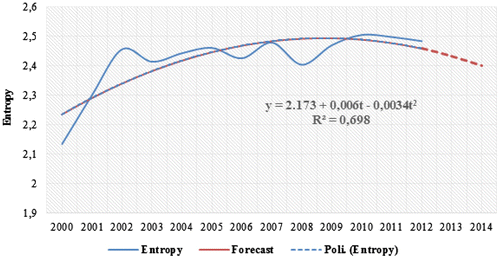
For non-life insurance, the quadratic trend model results for the entropy measure are presented in Table , showing that both the first and the second order terms in the trend model are statistically significant at 5% significance level.
Table 6. The quadratic trend of entropy for non-life insurance gross premium in Croatia, annual data in the period 2000–2012.
Unlike the entropy measure for life insurance gross premiums,which is characterised by a progressive-digressive trend, when it comes to the entropy measure for non-life insurance gross premiums the situation is the opposite. Namely, the entropy measure for non-life insurance fell in the first year by 0.0695 on average. However, that fall was not constant because the entropy measure in the rest of the observed period on average increased by 0.011 annually. Therefore, the entropy measure for non-life insurance gross premiums might be well described with the quadratic trend characterised by a digressive-progressive tendency (Table , Figure ). For the purpose of the short-term forecasting, in the following years, 2013 and 2014, a fall in the non-life insurance gross premiums concentration was anticipated, as given in Figure . The trend coefficient of determination R2 shows that the quadratic trend model, which indicates the medium representativeness of the model, explains 55.38% of the total sum of squares. For the non-life insurance gross premiums entropy, according to the estimated trend standard deviation and the trend coefficient of variation, the average deviation of the entropy measure empirical values from the trend values amounts to 0.0767, i.e. 3.30%, %, indicating that the estimated trend is highly representative.
Figure 6. The quadratic trend of entropy for non-life insurance gross premium in Croatia in the period 2000–2012 and forecasts for 2013 and 2014. Source: Economic reports and statistics (Citation2013), Croatian Insurance Bureau, Authors’ calculations.
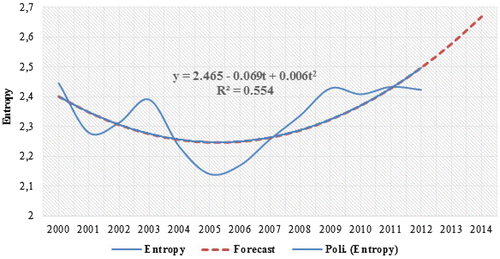
4.2. Comparison of descriptive statistics of entropy index for life and non-life insurance gross premiums
Table gives the descriptive statistics for entropy indexes. In addition, comparison of the features of dynamics of the gross written premiums for each type of insurance in Croatia in the period 2000–2012 is commented upon. The progressive-digressive trend for life and digressive-progressive for non-life insurance gross premiums influence the direction of the short term forecasts, shown in Figure and Figure for the time horizon τ=2.
Table 7. The descriptive statistics and the tendency for the entropy for life and non-life insurance gross premiums in Croatia in the period 2000–2012 and forecasts for 2014.
Having in mind that if H equals 0 there is a monopoly, and the higher the entropy index (H) the smaller the concentration of insurance gross premiums, the quadratic trend forecasted value H=2.60 for the non-life gross written premium in Croatia in 2014 means the further decrease of concentration for that kind of insurance. Just the opposite would happen to life gross written premiums in Croatia based on the same period data and the same regression forecasting model.
5. Conclusion
In the beginning of the twenty-first century the Croatian insurance market, showing a moderate level of market concentration, is not as developed as the western European market, and it is a small market with a great number of mutually competitive insurers. In order to present the tendency of concentration of gross written premiums of insurance companies in Croatia in the period from 2000 to 2012, the analysis of ten inequality measures as a time series was conducted. In the observed period, the market fragmented, showing decreased concentration.
The Croatian life insurance market is less concentrated in 2012 than in 2000.
For life insurance gross premiums, many calculated concentration measures and the Lorenz curve confirm this decrease of concentration, with the exception of maximum entropy, which indicates the stagnation, and the Rosenbluth index, which shows a mild increase, of life insurance gross premiums concentration. The number of insurance companies that sold life insurance did not change greatly, the smallest number of companies was 14 in 2006, but in 2000 and at the end of 2012 there were an equal number of them (17). However, the number of insurers did not change in 2012 compared to 2000, so, the conclusion that ‘the changing number of insurers’ might be reason for the decreased concentration in the period 2000–2012 does not hold.
On the non-life insurance market, the situation was very similar and the majority of calculated concentration measures, as well as the Lorenz curve, indicate a lower concentration of gross premiums in 2012 than in 2000. On the other hand, the entropy and the maximum entropy as well as the Rosenbluth index indicated the slight increase in concentration of non-life gross premiums in the same period. Slightly more insurers are competing in the non-life insurance market then in the life insurance market. The number of companies selling non-life insurance in that period was mostly between 16 and 24, while at the end of 2012 there were 20 insurers.
The concentration ratio C2 for life insurance in 2012 fell (1/3) in comparison to 2000 when it had its highest value (2/5) with the same number of active insurance companies at the market. In the same period, the concentration ratio C5 also decreased from 80% in 2000 to 60% in 2012. However, despite the decrease, the amounts of C5 above 60% indicate a relatively high concentration in the hands of five strongest life insurance market players.
The concentration ratio C2 for non-life insurance shows a constant downwards trend for portion of two strongest insurers in total gross premium for this type of insurance in the observed period. In 2000, when there were 24 insurers providing non-life insurance services and the ratio C2 equals 70% while in 2012 its value decreased to a still high 50%. The concentration ratio C5 also showed an important portion of five strongest insurers in total gross premium for non-life insurance in the observed period. The ratio C5 amounted to the highest 85% in 2001, and it fell to 75% in 2012. The values of both concentration ratios, C2 and C5, show a high concentration on the non-life insurance market in Croatia during the completely observed period.
The comparison of the indicator RI at the beginning and the end of the observed period testifies on the moderate rise of the index for both types of insurance, but despite that the values are very close to zero and there is no increase of monopoly on those markets.
Finally, both research hypotheses are proven. Since the existing inequality of distribution of gross written insurance premiums in Croatia in the period 2000 to 2012 is recognised, Hypothesis 1 may be accepted. It is found that concentration of gross written insurance premiums is higher for non-life than that for life insurance, so Hypothesis 2 is also proven. Based on the quadratic trend model forecasting of the entropy indexes, the dynamics is shown to be digressive-progressive for non-life, and progressive-digressive for life insurance.
Disclosure statement
No potential conflict of interest was reported by the authors.
References
- Bahovec, V., Dumičić, K., & Žalac, A. (2011). Trendovi u koncentraciji imovine mirovinskih fondova u Republici Hrvatskoj [Trends in concentration of pension funds assets in Croatia]. Zbornik Ekonomskog fakulteta u Zagrebu, 9, 54–75.
- Bauer, Ž. (2012). Mjerenje i prognoziranje koncentracije bruto premije u osigurateljnom sektoru Republike Hrvatske. Master work. Faculty of Economics and Business. Zagreb: University of Zagreb.
- Bikker, J. A. (2004). Competition and efficiency in a Unified European Banking market. Northampton: Edward Elgar Publishing Publishing.
- Cowell, F. A. (2003). Theil, Inequality and the structure of income distribution. London School of Economics and Political Science. Retrieved March 1, 2014, from http://sticerd.lse.ac.uk/dps/darp/darp67.pdf
- Dumičić, K., Čeh Časni, A., & Čibarić, I. (2008). Comparative analysis of bank concentration in selected South East European countries. In J.‐P. Guichard, V. Cantino, G. Dutto, M. Radović-Marković, S. Redžepagić, & H. Hanić (Eds.), Challenges of economic sciences in the 21st century (pp. 566–576). Belgrade: Institute of Economic Sciences.
- Dumičić, K., Pavković, A., & Akalović Antić, J. (2012). Mjerenje koncentracije u bankarstvu u Republici Hrvatskoj. Zbornik Ekonomskog fakulteta u Zagrebu, 10, 118–136.
- Economic reports and statistics. (2013). Croatian Insurance Bureau. Retreived December 6, 2013, from http//:www.huo.hr
- Insurance companies and re-insurance companies. (2013). Croatian Financial Services Supervisory Agency (HANFA). Retrieved January 15, 2013, from http://www.hanfa.hr/EN/nav/106/statistics.html#section0
- Jacquemin, A. (1987). The new industrial organization: Market forces and strategic behavior. Cambridge, MA: the MIT Press.
- Jakovčević, D. (2009). Utjecaj krize na hrvatski osigurateljni sektor. Retrieved January 16, 2014, from http://www.efzg.hr
- Jakovčević, D., & Krišto, J. (2012). Industrija osiguranja u Hrvatskoj: promjene u okruženju, novi proizvodi, regulacija i upravljanje rizikom. Zagreb: Grafit-Gabrijel.
- Ljubaj, I. (2005). Indeksi koncentracije bankarskog sektora u Hrvatskoj. Pregledi, P-21. Retrieved January 25, 2014, from http://www.hnb.hr/publikac/pregledi/p-021.pdf
- Martić, Lj. (1986). Mjere nejednakosti i siromaštva. Zagreb: Birotehnika.
- Morić Milovanović, B., & Galetić, F. (2005). Otvoreni investicijski fondovi u Hrvatskoj. Financijska teorija i praksa, 30, 79–91.
- Tipurić, D., Kolaković, M., & Dumičić, K. (2003). Koncentracijske promjene hrvatske bankarske industrije u desetogodišnjem razdoblju (1993.-2002.). Zbornik Ekonomskog fakulteta u Zagrebu, 1 (1), 1–20.
- Tipurić, D., Pejić Bach, M., & Pavić, T. (2008). Concentration of the insurance industry in selected transition countries of Central and Eastern Europe, 1998-2006. Post-Communist Economies, 20, 97–118.10.1080/14631370701865755
- Valdevit, M., Čibarić, I., & Žmuk, B. (2008). Poredbena analiza indeksa nejednakosti industrije otvorenih investicijskih fondova u Hrvatskoj od 1999. do 2007. Zbornik Ekonomskog fakulteta u Zagrebu, 6, 80–98.
- wessa.net. (2014). Contretacion-Free Statistics and Forecasting Software (Calculators). Retrieved January 16, 2014, from http://www.wessa.net
